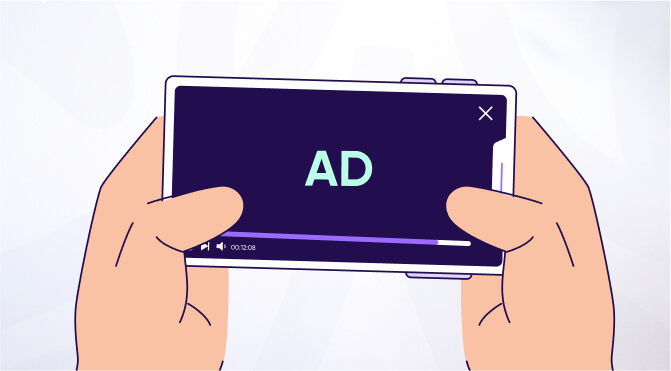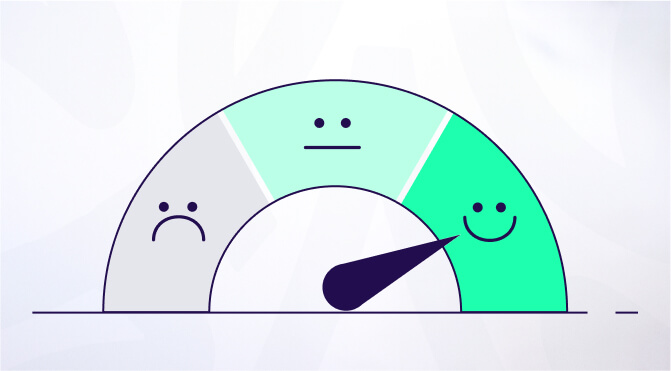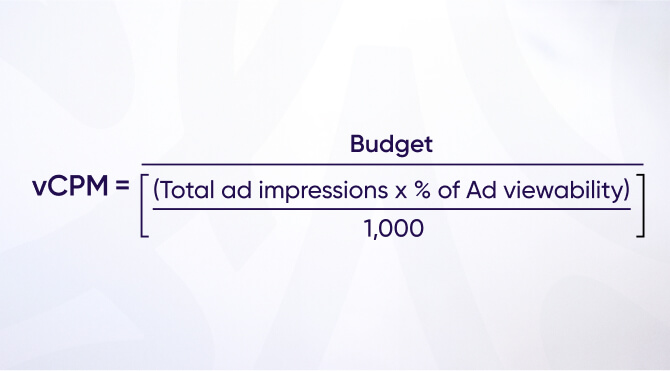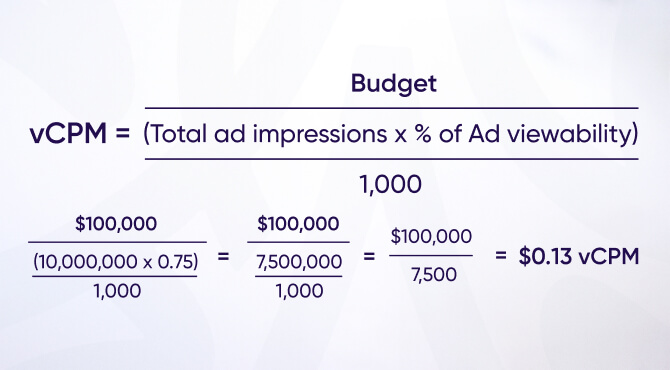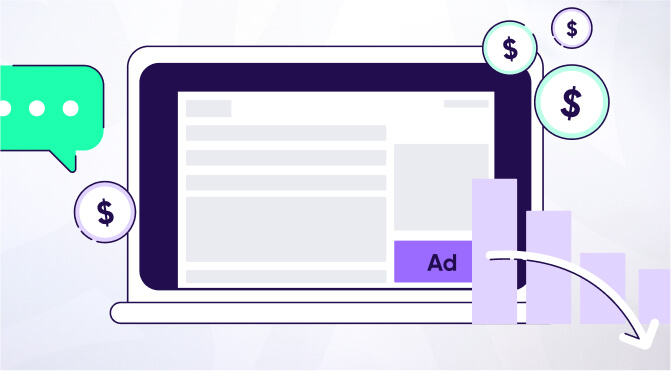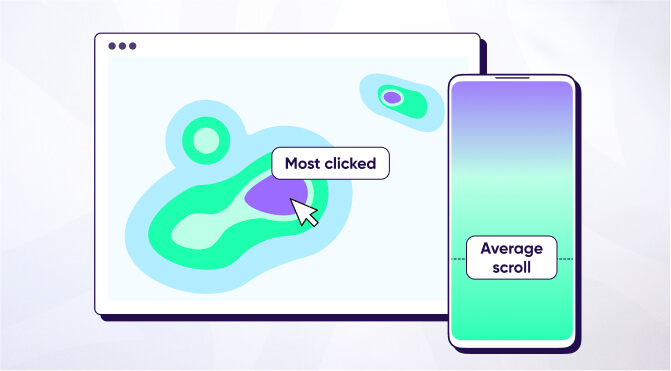Viewable CPM, or vCPM, is the cost per thousand views of a digital ad.
What is vCPM?
vCPM stands for viewable cost per mille, and it shows the cost of 1,000 views of a digital ad.
The key word here is viewable. vCPM is not just about users landing on the page where the ad appears — they need to actually see it. This gives both advertisers and publishers a truer picture of ad performance, helping them make strategic decisions that maximize revenue.
To count as viewable, an ad must meet these guidelines from the Media Rating Council (MRC):
- At least 50% of its area is visible on the screen for at least one second
- At least 30% of its area is visible for at least one second for large display ads (over 242,500 pixels)
- At least 50% of the video ad area is visible on the screen while video plays for at least two seconds
The digital advertising industry has improved viewability standards as a whole over the past few years. The global digital video viewability rate in 2017 was just 59%, but this increased to 73% in 2022.
What are the benefits of using vCPM?
Focusing on actual views has a number of benefits for both advertisers and publishers.
Promotes transparency between advertisers and publishers
Clear guidelines on what ads are being seen by consumers are critical to accurately reporting the effectiveness of your ad spend. These guardrails hold publishers to a higher standard, preventing them from over-reporting ad performance, and ultimately boost ROI for advertisers.
Shows advertisers the true value of an impression
With vCPM, advertisers can measure with confidence, knowing that they’re paying for ads that are actually viewed. For example, if an ad performs poorly, you can attribute it to targeting or the creatives — and improve these accordingly — rather than worrying about whether the ad is being seen at all.
Helps publishers improve the user experience
Measuring vCPM gives publishers a better understanding of how their audience is engaging with their content. With this insight, they can improve the user experience — resulting in improved fill rates, increased competition, and ultimately higher revenue.
How to calculate vCPM
Now that you understand when and why to use vCPM, let’s examine the numbers in a real-world scenario.
The vCPM formula is as follows:
vCPM = Budget / [(Total ad impressions x % of Ad viewability) / 1,000]
Let’s say you’re advertising your tennis scorekeeping app, Tenniscore, with the following variables:
- Ad campaign budget: $100,000
- Percentage of ad viewability: 75%
- CPM: $1.50
- Total impressions: 10,000,000
- Viewable impressions: 7,500,000
- Maximum vCPM bid: $5.00
Now let’s plug the variables back into the vCPM formula.
So, the cost per 1,000 viewable impressions for Tenniscore is 13 cents.
vCPM vs. CPM — what’s the difference?
CPM is the cost per thousand impressions of an ad, and vCPM is the cost per thousand viewable impressions. CPM measures the number of times an ad loads on a website, without any guarantees that the ad will be viewed. Because this represents a larger gamble, it’s often much cheaper than vCPM.
The benefit of CPM for publishers is that they receive a guaranteed payment for an ad to load without having to measure the viewability percentage of every ad inventory slot. However, this comes at the cost of the ad inventory being less desirable, meaning lower revenue potential and fill rates.
What are the main causes of low ad viewability?
Before we discuss the different strategies for improving viewability, let’s consider the biggest pitfalls that cause low viewability rates.
- Page length: Shorter pages with less content load faster, and have higher viewability. Single-fold pages (that don’t require scrolling) are especially fast.
- Ad placement: Most ads placed below the fold (so users have to scroll to see them) have lower viewability rates.
- User experience: Websites with poor overall user experience cause users to click away and not engage with the content.
- Internet speed: Slow internet connections won’t load bloated websites and ads.
How do you improve ad vCPM?
Now that we understand the primary causes of low visibility, let’s discuss ways to improve ad vCPMs.
Remember to conduct A/B tests on various ad sizes, positions, and formats, including video and static ads. Even if you have space for a huge banner across the top of your website, it might not be the highest-performing ad unit. In fact, according to Google, the most viewable position is at the bottom of the page, right above the fold.
Some publishers claim that the most viewable ad sizes are vertical ads, which stay in view longer than horizontal ones. Banners that stick to the top or bottom of the page can also be effective.
2. Improve ad load speed
If you load all your ads at once, regardless of whether they’re placed above or below the fold, there’s a chance that a user might not see any ads at all. Instead, implement lazy loading, which prioritizes loading the ads above the fold, and then the ads below it. Another tip is to reduce the number of ad calls from one server to another. This reduces page latency and improves the overall user experience.
The best way to understand your audience’s behavior on your website is to implement heatmap tools that can measure where user eyeballs are going.
This data provides an objective view of where to place ads and how new ad placements may be affecting your user experience.
4. Find balance
While it may be tempting for publishers to squeeze as many ads as possible above the fold of the website, consider the user-experience trade-off. A website with a great user experience and engaging content will yield high ad viewability and keep users coming back.
Key takeaways
- Viewable CPM, or vCPM, is the cost per thousand actual views of a digital ad, rather than just page impressions.
- vCPM enhances transparency for advertisers and sets higher standards for publishers. Stricter measurement guidelines give advertisers a better understanding of ad performance, and enable publishers to charge more for desirable inventory.
- Low viewability can be due to wrong ad sizes or placements, slow load times, long page length, and poor user experiences.
- To improve viewability, publishers should optimize their ad sizes and formats, improve load times, and focus on improving the overall user experience.
Viewable CPM, or vCPM, is the cost per thousand actual views of a digital ad, measured according to industry-wide viewability standards. This is in contrast to CPM, which is the cost of a thousand ad impressions (regardless of whether a user sees them).
How do you calculate vCPM?
The formula for vCPM is as follows: vCPM = Budget / [(Total ad impressions x % of Ad viewability) / 1,000].
How is vCPM different from CPM?
CPM (cost per mille) measures the cost per thousand ad impressions. It’s a broad metric that doesn’t account for actual ad views. On the other hand, vCPM follows global measurement standards that consider the actual views of an ad. This gives a more accurate picture of ad performance that helps both advertisers and publishers to maximize revenue.
What are the benefits of using vCPM?
vCPM improves transparency and trust between advertisers and publishers, and encourages a better user experience. Advertisers only pay for ads that are viewed, while publishers can charge a higher premium for these guarantees.

